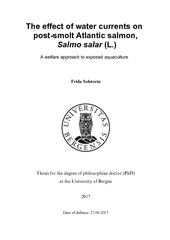| dc.contributor.author | Solstorm, Frida | |
| dc.date.accessioned | 2017-06-29T13:17:43Z | |
| dc.date.available | 2017-06-29T13:17:43Z | |
| dc.date.issued | 2017-06-27 | |
| dc.identifier.uri | http://hdl.handle.net/1956/16129 | |
| dc.description.abstract | The future development of Atlantic salmon (Salmo salar L.) aquaculture is limited by the availability of space and suitable environments along coastal areas. Utilising exposed areas is a possible solution to this problem. The technology for offshore and exposed aquaculture is well developed, but there is a lack of knowledge concerning the effect of fast water current velocities on fish. In some locations, velocities exceed what is considered the critical swimming speed for salmon. Exposing salmon to such fast currents could severely compromise their welfare. Therefore, it is of utmost importance to evaluate the effects of strong water currents on individual fish. As a first approach, field observations were conducted at an exposed site where salmon behaviour was monitored in relation to current velocity. A behavioural adaptation to fast currents was observed at an ambient current velocity of approximately 0.7 BL s-1. At this velocity, some fish broke their circular schooling behaviour and maintained position against the current, creating a mix of swimming behaviours, i.e., both circular and standing on the current. Further increases in velocity (0.9 BL s-1) resulted in all fish abandoning the circular swimming behaviour to stand on the current. To explore the effect of a single parameter, water current velocity, a six-week laboratory experiment was conducted. Atlantic salmon post-smolt were exposed to three different velocities in raceways; slow (0.2 BL s-1), moderate (0.8 BL s-1) and fast (1.5 BL s-1). The setup forced the fish to primarily swim at the prevailing velocity. Fish growth, muscle composition and blood chemistry were analysed before and after the experiment. All fish were also examined for fin erosions, external injuries, skeletal morphology and bone composition. The fish behaviour was studied in detail throughout the experiment. The setup did not allow for circular swimming behaviour, as can be observed in sea cages. However, the plasticity of salmon behaviour was also clear in this setup, and the fish adapted quickly to the prevailing conditions. Slower velocities gave the fish more opportunities to interact with each other, whereas fish in the fast current velocity mainly swam against the current. A fast velocity also resulted in isometric growth that was lower than was observed for moderate and slow velocities. Fish kept in a slow or moderate current velocity experienced the same weight gain, but fish at slow velocity gained more fat, whereas fish at moderate velocity gained more protein in white muscle. This suggests that a moderate swimming speed is optimal in terms of production performance. Additionally, individuals at slow velocity had elevated levels of stress hormones, thus indicating that this velocity is stressful. In sea cages, slow velocities are typically related to poor water quality, but in the laboratory experiment, the stress was likely a response to interacting behaviours. The fin quality of the fish was best at slow and moderate velocity. At fast velocity, an increase in new fin erosions due to unintentional collisions with obstacles and other fish was observed. This should be considered in exposed aquaculture, where fish may have difficulties holding their positions in fast currents. Water current velocities also affected the vertebrae in terms of morphology, mineral rate and mineral composition. Region-specific effects were observed: mineral rate increased with velocity in the post-cranial and anterior-caudal regions, and relative vertebrae length increased in the post-cranial region and decreased in the ural region. Velocity effects on mineral composition differed between regions and minerals studied. This highlights the importance of considering which region to study. In conclusion, this thesis represents a first approach for studying how fish are affected by currents in aquaculture. It emphasises the importance of including water current as a parameter in all types of aquaculture. Currents have been demonstrated to cause both positive and negative effects and can be used as an important tool for optimising production and welfare. | en_US |
| dc.language.iso | eng | eng |
| dc.publisher | The University of Bergen | en_US |
| dc.relation.haspart | Paper I: Johansson, D., Laursen, F., Fernö, A., Fosseidengen, J. E., Klebert, P., Stien, L. H., Vågseth, T., & Oppedal, F. (2014): “The interaction between water currents and salmon swimming behaviour in sea cages”, PLoS ONE 9:e97635. The article is available at: <a href="http://hdl.handle.net/1956/9570" target="blank">http://hdl.handle.net/1956/9570</a> | en_US |
| dc.relation.haspart | Paper II: Solstorm, F., Solstorm, D., Oppedal, F., Fernö, A., Fraser, T. W. K., & Olsen, R. E., (2015): ”Fast water currents reduce production performance of post-smolt Atlantic salmon Salmo salar”, Aquaculture Environment Interactions, Vol. 7: 125-134. The article is available at: <a href="http://hdl.handle.net/1956/10778" target="blank">http://hdl.handle.net/1956/10778</a> | en_US |
| dc.relation.haspart | Paper III: Solstorm, F., Solstorm, D., Oppedal, F., & Fjelldal, P. G., (2016): “The vertebral column and exercise in Atlantic salmon – regional effects”, Aquaculture, Vol. 461: 9- 16. The article is available in the main thesis. The article is also available at: <a href="https://doi.org/10.1016/j.aquaculture.2016.04.019" target="blank">https://doi.org/10.1016/j.aquaculture.2016.04.019</a> | en_US |
| dc.relation.haspart | Paper IV: Solstorm, F., Solstorm, D., Oppedal, F., Olsen, R. E., Stien, L. H., & Fernö, A., (2016): “Not too slow, not too fast: water currents affect group structure, aggression and welfare in post-smolt Atlantic salmon, Salmo salar”, Aquaculture Environment Interactions, Vol. 8: 339-347. The article is available at: <a href="http://hdl.handle.net/1956/16128" target="blank">http://hdl.handle.net/1956/16128</a> | en_US |
| dc.subject | Atlanterhavslaks | Nob |
| dc.subject | Hydrodynamikk | Nob |
| dc.title | The effect of water currents on post-smolt Atlantic salmon, Salmo salar (L.). A welfare approach to exposed aquaculture | en_US |
| dc.type | Doctoral thesis | |
| dc.rights.holder | Copyright the Author. All rights reserved | en_US |
| dc.subject.realfagstermer | https://data.ub.uio.no/realfagstermer/c012698 | |
| dc.subject.realfagstermer | https://data.ub.uio.no/realfagstermer/c011907 | |
| dc.identifier.cristin | 1479755 | |
